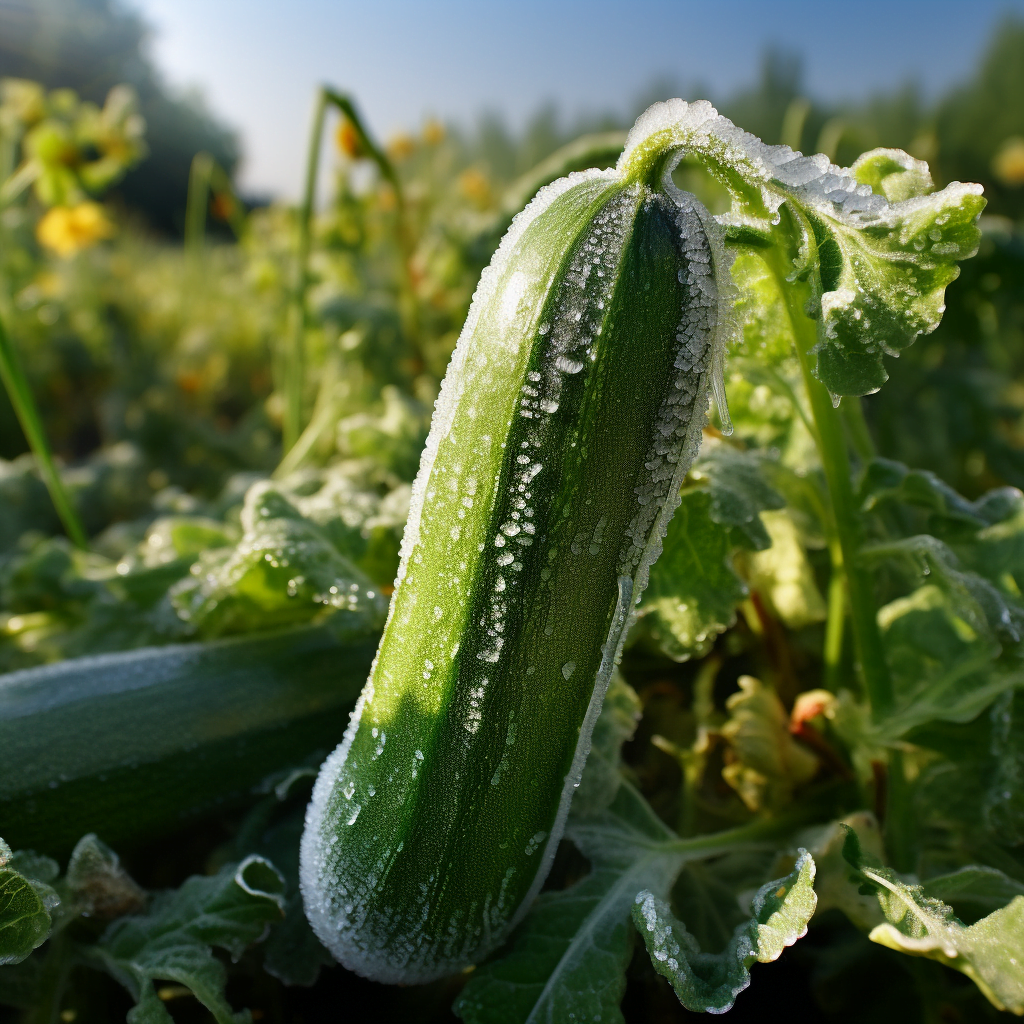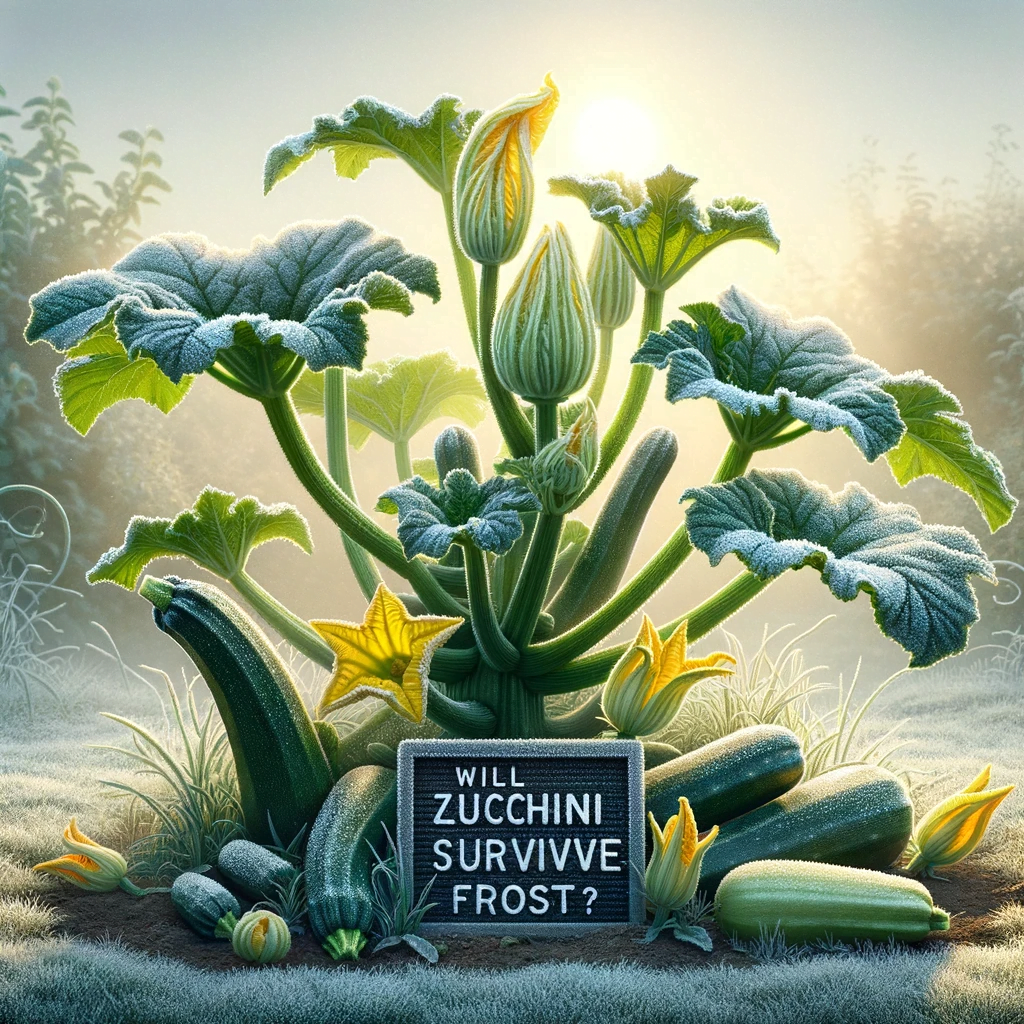Gardening is an art that intertwines with the science of horticulture, especially when it comes to understanding the whims of Mother Nature. One particular concern that often plagues gardeners is whether their tender plants, like zucchini, can withstand the cold bite of frost. In this comprehensive guide, we’ll delve deep into the resilience of zucchini plants to frost, how to spot and manage frost damage, and effective strategies to protect these beloved garden staples from chilly weather.
Understanding Frost and Its Effects on Plants
Frost occurs when the temperature dips low enough for water vapor in the air to freeze. This can spell trouble for plants, as the ice crystals formed can rupture cell walls, leading to wilting, browning, and the potential demise of the plant. Zucchini, being a warm-season crop, is particularly sensitive to these cold temperatures.
What exactly is frost? In simple terms, it’s the coating or deposit of ice that may form in still air on objects, especially at night, when the temperature falls below the freezing point. For gardeners, frost can either be a light nuisance or a plant’s worst nightmare, depending on several factors including the type of frost and the plant’s own hardiness.
Types of Frost
- Hoarfrost: This picturesque frost forms delicate, feathery crystals on plants and surfaces. It’s formed by direct condensation of water vapor to ice at temperatures below freezing and often occurs under clear sky conditions.
- Rime: A less common form of frost, rime is a rough, milky ice deposit that forms quickly, usually in windy conditions.
- Black Frost: This occurs when temperatures drop so low that frost doesn’t form, but plant tissues freeze and die, turning black.
The Resilience of Zucchini to Cold Weather
Zucchini, a type of summer squash, thrives in warm, frost-free weather, typically needing temperatures between 60°F and 75°F for optimal growth. But can zucchini plants survive a light frost? The answer isn’t straightforward. While mature zucchini plants might endure a brief, light frost, young seedlings are far more susceptible to damage.
Zucchini’s Growing Conditions
Zucchini plants prefer:
- Well-drained soil with plenty of organic matter.
- Full sun exposure for at least 6-8 hours a day.
- A consistent watering schedule, as they have shallow roots.
Temperature Thresholds for Zucchini Plants: Zucchini plants are most productive when nighttime temperatures are above 60°F and daytime temperatures are below 95°F. When temperatures fall below 50°F, growth slows down, and below 40°F, zucchini plants are at risk of damage.
Factors That Influence Zucchini’s Frost Tolerance
Several factors can affect a zucchini plant’s ability to weather the cold:
- Age and Maturity: Mature plants have a better chance of surviving. Their larger size and established root systems can often withstand colder temperatures better than young seedlings.
- Plant Health: Vigorous plants with no existing stress factors are more resilient. A plant already struggling with pests, diseases, or nutrient deficiencies will have a harder time coping with frost.
- Acclimatization: Gradually exposing plants to cooler temperatures can enhance their tolerance. This process, known as “hardening off,” involves transitioning plants from a protected environment to the outdoors gradually.
Identifying Frost Damage in Zucchini Plants
Frost damage in zucchini plants is often characterized by:
- Darkened, water-soaked patches on leaves and stems.
- Wilted and limp foliage.
- Browned or blackened growth.
If the frost was light and brief, your plants might bounce back. However, a heavy frost can cause irreversible damage.
Assessing the Damage
After a frost event, it’s crucial to assess the damage before taking action. Here’s how:
- Wait: Give the plants a day or two to show the full extent of the damage. Sometimes, plants can recover from what initially looks like severe damage.
- Inspect: Look for the tell-tale signs of frost damage mentioned above.
- Evaluate: Determine whether the plant’s main growing points are still alive. If they are, there’s a good chance the plant can recover.

Preventative Measures to Protect Zucchini from Frost
Here’s how you can safeguard your zucchini plants from an unexpected frost:
- Forecasting: Keep an eye on weather reports during the growing season.
- Protective Covers: Use frost cloths or blankets to cover plants at night.
- Mulching: Apply a thick layer of mulch around the base to insulate the soil.
- Raised Beds: Consider raised beds for better drainage and insulation.
Detailed Preventative Strategies
Forecasting and Planning
- Weather Apps: Use reliable weather apps or services to stay updated on temperature changes.
- Planting Schedule: Plan your planting schedule around the average last frost date in your area to minimize risk.
Protective Covers
- Materials: Utilize burlap, bed sheets, or commercial frost cloths.
- Application: Ensure the covers extend to the ground to trap heat effectively.
- Removal: Remove covers during the day to allow for light and air circulation.
Mulching
- Materials: Straw, leaves, or wood chips can serve as excellent mulch.
- Thickness: Apply mulch 2-4 inches thick around the base of the plants.
Raised Beds
- Construction: Build or buy raised beds that can be easily covered.
- Benefits: Raised beds warm up faster in the spring and offer better drainage, which can help protect against both frost and root rot.
Emergency Actions When Frost is Imminent
When frost looms on the horizon, take these immediate steps to protect your zucchini:
- Cover Up: Drape frost cloths over your plants, securing them to the ground to trap heat.
- Uncover Promptly: Remove covers as soon as temperatures rise to avoid overheating.
Step-by-Step Emergency Frost Protection
- Gather Materials: Have your frost protection materials ready in advance.
- Act Quickly: As soon as a frost warning is issued, cover your plants.
- Secure Covers: Make sure the covers are secure so they don’t blow away during the night.
- Monitor Conditions: Keep an eye on the weather and be ready to uncover your plants once the frost threat has passed.
Post-Frost Care for Zucchini Plants
After a frost event, you should:
- Assess Damage: Wait for a day or two to see the full extent of the damage.
- Prune Judiciously: Remove only the damaged parts to prevent disease.
- Support Recovery: Provide ample water and consider a light fertilizer to help recovery.
Recovery Tips
- Watering: Water the plants in the morning to help them recover from the night’s cold.
- Fertilizing: Use a balanced, water-soluble fertilizer to give your plants a nutrient boost.
- Pruning: Use clean, sharp shears to remove only the frost-damaged parts.
Alternative Strategies if Zucchini Plants Don’t Survive Frost
If frost claims your zucchini plants, consider these alternatives:
- Start Seedlings Indoors: This can give you a head start on the growing season.
- Frost-Resistant Varieties: Opt for varieties known to be more cold-tolerant.
- Greenhouses: Utilize greenhouses or cold frames to extend the growing season.
Exploring Alternatives
Starting New Plants
- Timing: Start new seedlings indoors 4-6 weeks before the last expected frost date.
- Equipment: Use grow lights and heating mats to simulate ideal growing conditions.
Frost-Resistant Varieties
- Research: Look for zucchini varieties bred for cooler climates.
- Seed Suppliers: Consult with local nurseries or extension services for recommendations.
Greenhouses and Cold Frames
- Benefits: These structures can extend your growing season by several weeks or even months.
- Considerations: Factor in the cost, space, and time required to manage these structures effectively.
Frequently Asked Questions
- Will zucchini plants come back after frost?
It depends on the severity of the frost and the health of the plant. - How long can zucchini plants be exposed to frost?
Brief exposure to light frost is survivable, but prolonged exposure can be fatal. - Can zucchini still produce fruit after a frost?
If the plant survives and the growing conditions improve, it can still produce fruit. - What temperatures can kill zucchini plants?
Temperatures below 32°F can be lethal, especially for extended periods.
Conclusion
Protecting zucchini from frost requires vigilance, preparation, and prompt action. By understanding the risks and implementing the strategies outlined in this guide, you can give your zucchini plants the best chance to thrive throughout the growing season. Remember, gardening is a journey of learning and adaptation – each challenge faced is an opportunity to grow your green thumb.
Additional Resources
For those looking to dive deeper into frost protection and zucchini care, here are some valuable resources:
- National Weather Service for up-to-date frost warnings.
- Cold-Hardy Vegetable Gardening for tips on growing resilient crops.
By equipping yourself with the knowledge and tools to combat frost, you’ll be well on your way to a bountiful zucchini harvest, regardless of the cold snaps that nature throws your way.



